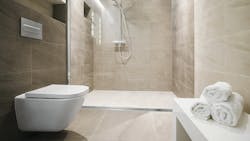Hotel Renovation Trends: Why Tub-to-Shower Conversions Are Becoming Standard
Transforming bathtubs into showers has become a common practice in the hospitality industry. Hotels are rapidly removing built-in tubs, making way for more spacious and functional showers. As bathroom footprints grow, the prominence of showers in hotel design increases, with built-in bathtubs becoming a thing of the past.
The move toward tub-to-shower conversions aligns with evolving hospitality design trends. However, executing these conversions efficiently and cost-effectively remains a significant challenge for contractors handling large-scale hotel renovations.
A reliable tub-to-shower conversion system is key to simplifying this process. The ideal system offers customizable components that can adapt to nearly any shower enclosure size or configuration. These systems often include elements like site-modifiable linear drains, waterproofing features, pre-sloped PET (polyethylene terephthalate) shower panels, and matching drain covers. Such features make it easier to streamline the conversion process while meeting design and functional demands.
Replacing built-in tubs with spacious showers not only enhances design aesthetics but also addresses other significant trends in the hospitality industry. Let’s explore how these conversions tie into broader trends like luxury, accessibility, and cleanliness.
Designing for Luxury
Post-pandemic hotel bathroom designs focus on creating spaces that promote relaxation and comfort. Luxurious features such as steam showers, heated towel racks, and digital mirrors are increasingly common. Converting old bathtubs into large, spa-like showers elevates the sense of luxury and transforms bathrooms into tranquil retreats.
Trendy finishes, including rose gold and matte black, remain popular, adding a sophisticated touch to fixtures and shower drains.
Why do hotel bath designers favor the appearance and versatility of linear drains? From a design standpoint, a wall-to-wall linear drain optimizes drainage and offers a sleek look that enhances the guest’s showering experience.
Additionally, bath designers value the freedom from tile size restrictions often associated with center-point drains that slope in all directions. Linear drains, by contrast, open up opportunities for diverse tile choices, including large-format or mosaic tile sheets.
That was certainly the case at the Renaissance Phoenix Downtown Hotel. Pursuit Builders Inc. converted nearly 250 bathtubs to showers, using linear shower drains and on-site adjustable, pre-sloped PET shower pans. The linear drains generated new design opportunities, featuring rectangular, 18- by 36-inch tiles that created an uninterrupted flow from the rest of the bathroom to the shower.
Prioritizing Accessibility
The hospitality industry prides itself on providing the very best experience for hotel guests, including maximizing accessibility for visitors with disabilities. To that end, the industry is increasingly prioritizing universal bathroom design.
Hotel operators want to create larger showers that can also be made ADA-accessible with a quick and simple modification; for example, if someone needed a bench, it can be easily brought in. As a consequence, older bathtubs are converted into larger and more accessible showers.
Enhancing Cleanliness and Maintenance
Maintenance is significantly reduced with showers instead of bathtubs. Labor savings and work satisfaction of employees is a significant consideration for hotel ownership groups.
Cleaning showers vs. bathtubs decreases the risk from a safety and insurability perspective. Hotel employees not having to lean over a wet tub to clean it saves a considerable amount of time while reducing the risk of injury. Curbless showers with a linear drain make for easier maintenance and cleaning by directing the water towards a drain that slopes in a single direction.
Ease of maintenance within hotel showers is crucial to enhanced cleanliness. A linear drain offers lower maintenance because it can be integrated with larger-format tiles. The latter have fewer grout joints and seams where mold, mildew, and grime can occur.
Key Considerations for Tub-to-Shower Conversions in Hotels
Converting tubs to showers in commercial buildings can present a unique set of challenges. Here are several crucial aspects hotel ownership and commercial contractors will want to consider when planning to convert tubs to showers.
Time savings: Efficient systems can save contractors significant time during the conversion process. For example, traditional mortar bed installation requires multiple days for drying, waterproofing, and testing. Modern conversion systems eliminate these delays, allowing contractors to complete a floor’s worth of shower installations in a single day.
On-site customization: More often than not, when contractors demo out tubs, they run into different conditions in practically every bathroom. Rarely will they take out a tub and have a space that is exactly 30 by 60 inches, as it says on the construction plans.
This was the case at the Four Seasons Hotel in Houston, where the construction team encountered numerous job-site irregularities. The team had to find a solution that would allow them to adapt to unexpected plumbing rough-in configurations and various shower enclosure sizes. What was needed was a tile-ready and site-sizable pan to contend with a full-range of rough-in configurations.
They discovered a conversion system with site-adjustable components—like pre-sloped PET panels and linear drain extensions—to help adapt to these irregularities without costly modifications.
Avoiding core drilling: Older hotel constructions often feature off-center drain placements. In multi-story buildings with post-tensioned slabs, core drilling to reposition drains can compromise structural integrity. Offset drain solutions included in tub-to-shower systems enable contractors to work around these challenges efficiently.
Conclusion
The shift from tubs to showers in hotel renovations is driven by the demand for luxurious, accessible, and easy-to-maintain bathrooms. Leveraging a customizable tub-to-shower conversion system helps contractors address common renovation challenges while delivering modern, spa-like bathroom designs that meet guest expectations.
About the Author
Randy Peyton
Randy Peyton, Hospitality Sales Manager for Oatey Company and QuickDrain, has been in the hospitality industry for more than 15 years, based in the Washington, DC, metro area. He works with hotel owners, operators, general contractors, and installers, covering the United States.
